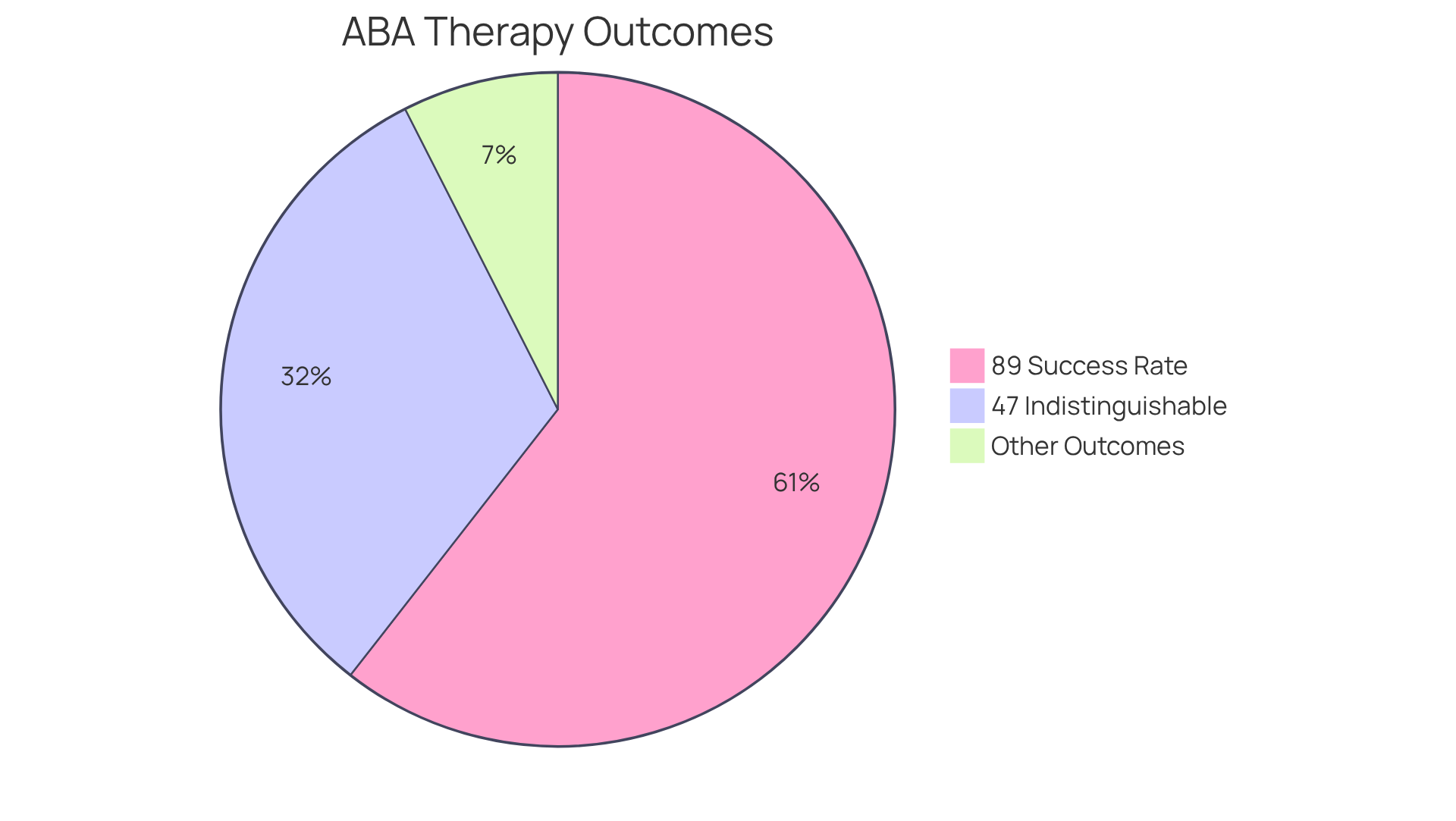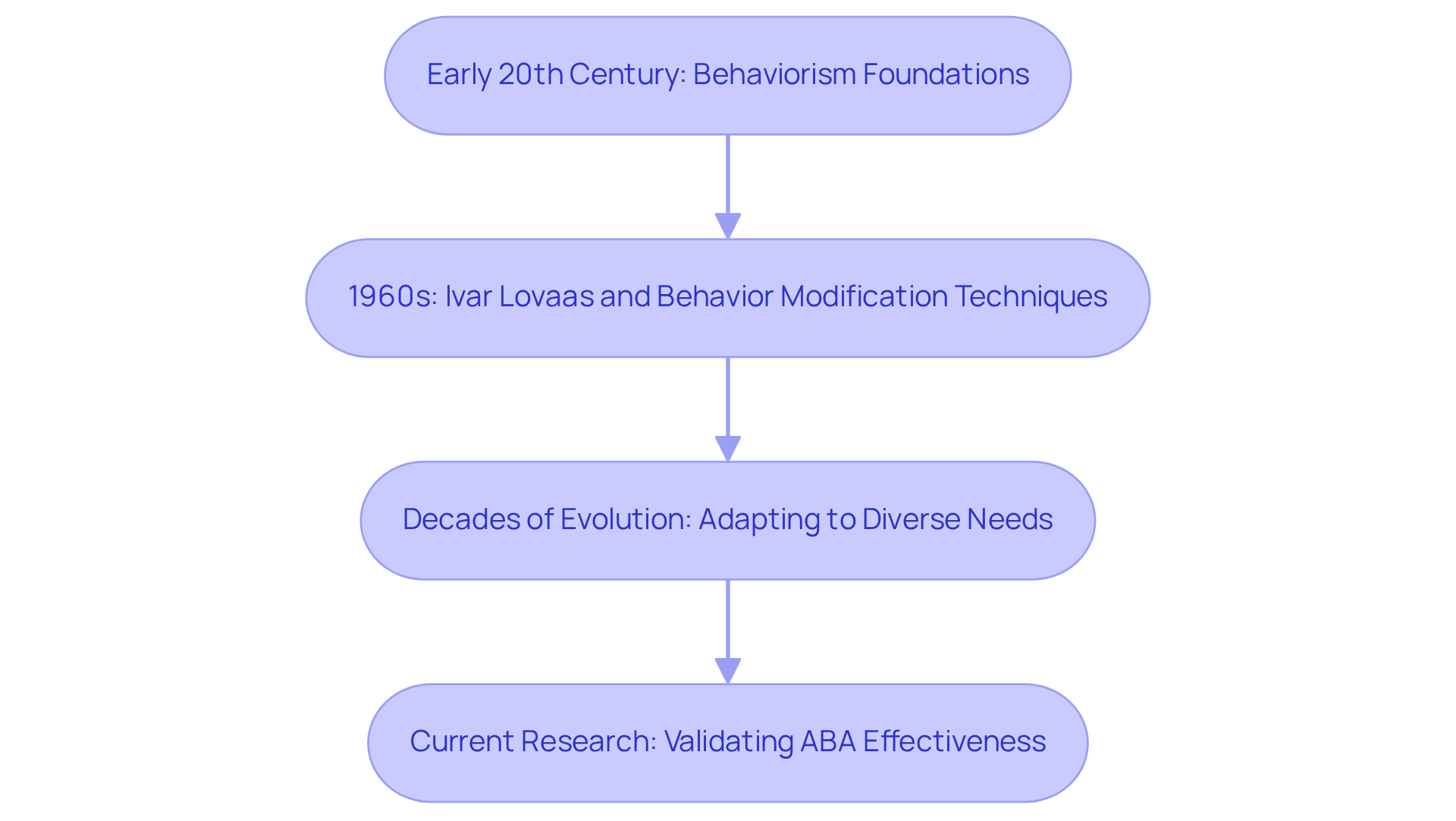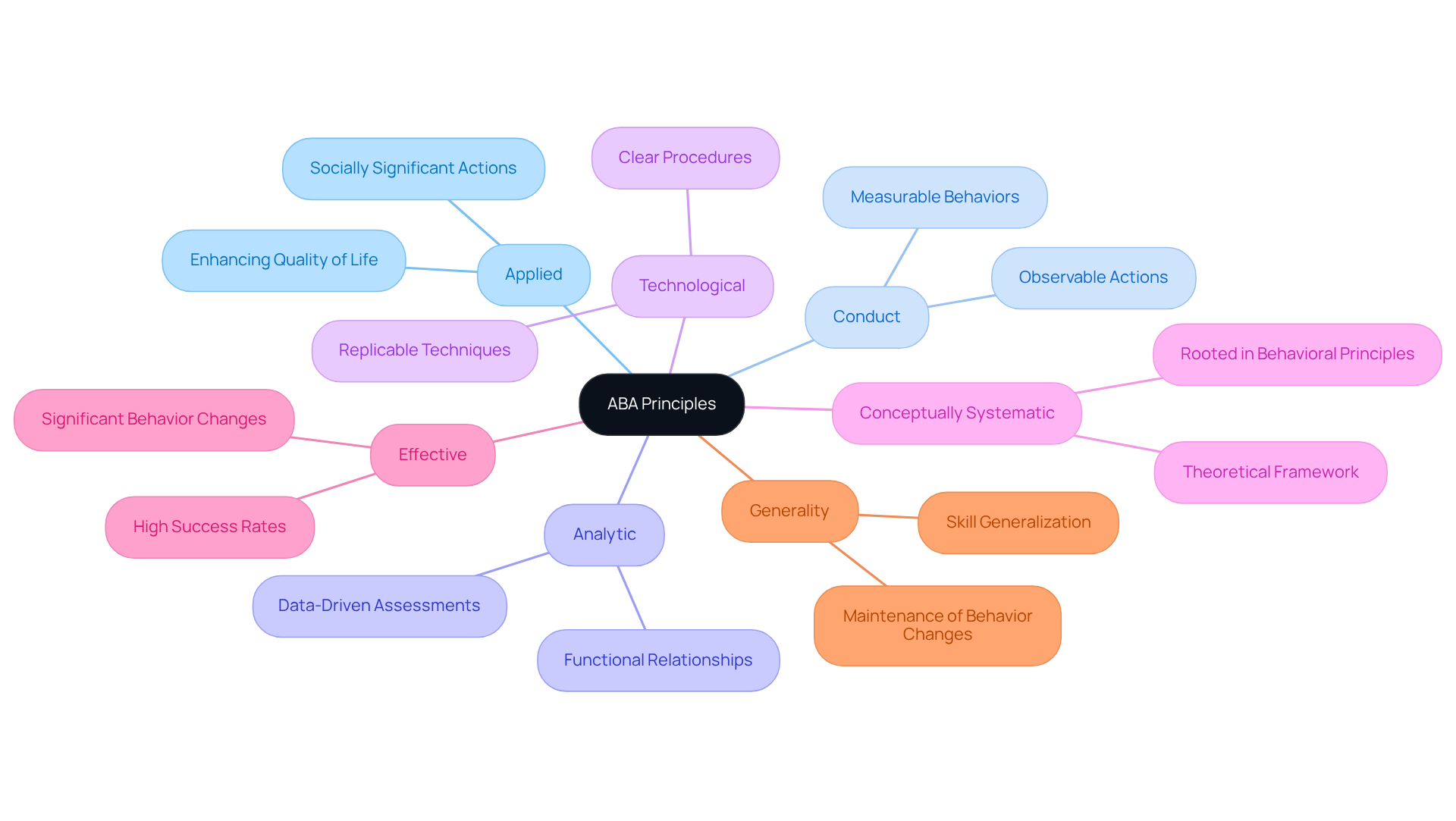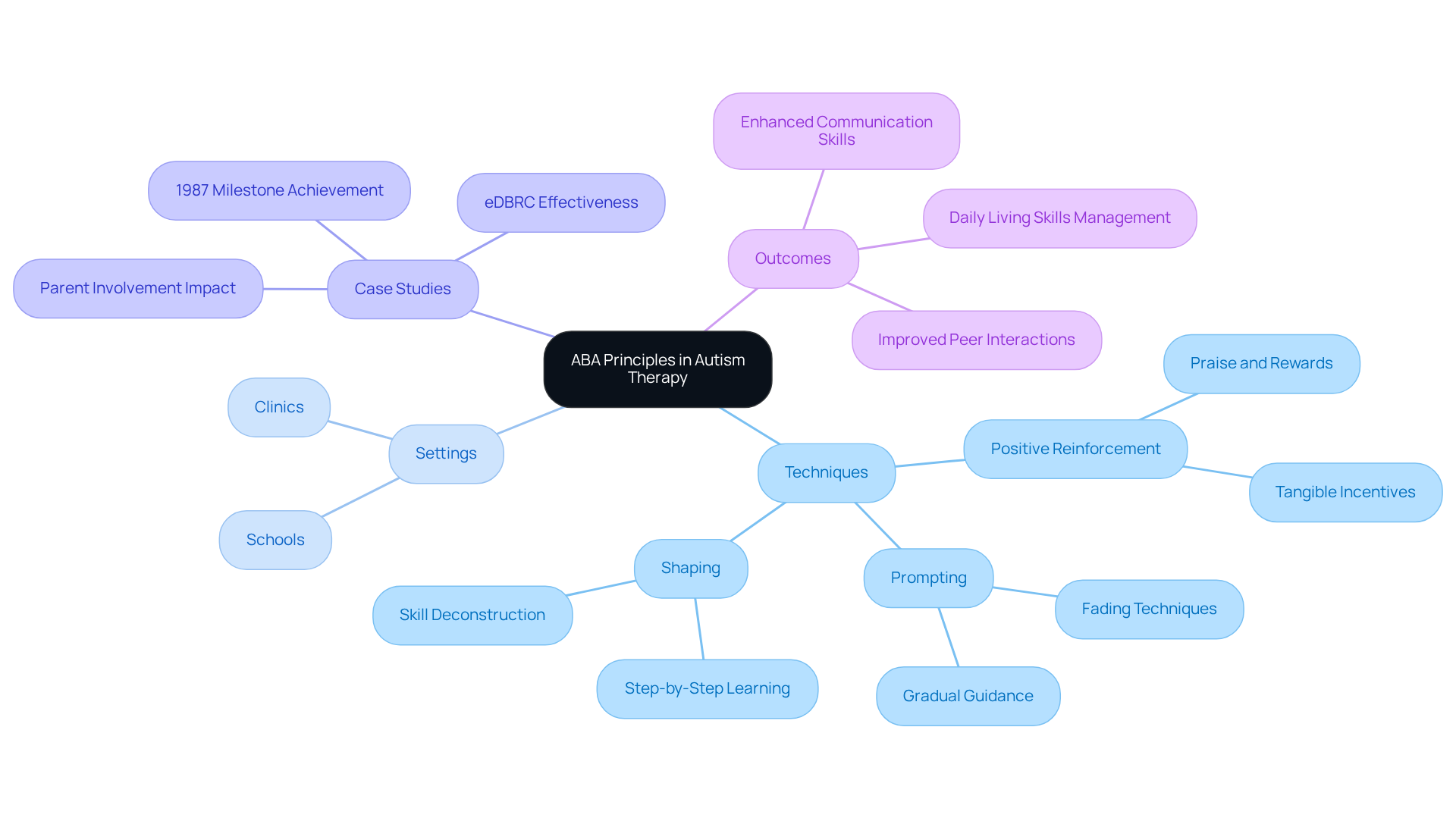September 23, 2025

The article emphasizes the critical role of Applied Behavior Analysis (ABA) principles in autism therapy, showcasing their origins, significance, and applications. It illustrates how ABA enhances the quality of life for individuals on the spectrum. Notably, the effectiveness of ABA is supported by compelling statistical success rates, historical context, and specific therapeutic techniques that yield significant improvements in communication and social skills among children with developmental disorders.
This highlights the demand for Board Certified Behavior Analysts (BCBAs) and underscores the benefits of utilizing Hire ABA for recruitment, ensuring that healthcare employers can access qualified professionals to meet their needs.
Reflect on your current hiring challenges—how can Hire ABA assist in overcoming these obstacles? With a proven track record, Hire ABA stands out as a reliable platform for connecting with skilled BCBAs, making it an essential resource for enhancing your team and improving patient outcomes.
Applied Behavior Analysis (ABA) principles stand as a cornerstone in the treatment of individuals with autism, providing a structured approach to behavior modification that yields remarkable results. By systematically observing and intervening in behaviors, ABA not only enhances essential skills but also significantly improves the quality of life for those on the spectrum.
However, as the field evolves, questions emerge regarding the balance between effective treatment and the dignity of individuals receiving therapy.
The modification of actions, particularly in therapy for individuals with developmental disorders, relies heavily on Applied Behavior Analysis (ABA) principles as essential guidelines. These principles underscore the , aiming to enhance positive behaviors while diminishing negative ones. The primary objective of ABA is to elevate the quality of life for individuals on the spectrum by fostering crucial skills.
Recent studies reveal that significant advancements in communication, social skills, and daily living activities for children on the spectrum result from intensive and long-term applications of ABA principles. For instance, research shows that children receiving early intensive behavioral support grounded in ABA principles demonstrate notable progress in cognitive and language abilities, achieving an impressive overall success rate of 89% in addressing developmental disorders through the application of ABA principles in therapy.
Real-world examples further illustrate the transformative potential of ABA therapy; one child progressed from non-verbal to verbal communication, markedly improving interactions with peers and family. Moreover, statistics indicate that 47% of children who undergo intensive ABA therapy become indistinguishable from their peers, highlighting the effectiveness of these interventions.
Acknowledged by the US Surgeon General and the American Psychological Association, ABA stands as an evidence-based best practice treatment, emphasizing its critical role in supporting individuals with developmental disorders.

The origins of Applied Behavior Analysis (ABA) trace back to the early 20th century, rooted in the principles of behaviorism established by psychologists such as John B. Watson and B.F. Skinner. The ABA principles serve as a scientific method for comprehending and altering actions, concentrating on observable activities and their connection to the environment. The structured advancement of ABA as a unique therapeutic method began in the 1960s with Dr. Ivar Lovaas, who conducted pioneering research on behavior modification techniques for children with developmental disorders. His groundbreaking work marked a significant milestone in the evolution of ABA principles, which led to its recognition as a leading evidence-based practice for treating individuals with developmental disorders. Notably, studies indicate that 90% of individuals achieve remarkable progress when recommended hours are fully implemented with active caregiver participation, underscoring the effectiveness of ABA therapy.
Over the decades, ABA has evolved, incorporating advancements in behavioral science and adapting to the needs of diverse populations. This includes the growing recognition of neurodiversity, which emphasizes the value of different neurological conditions. Today, ongoing research continues to validate the effectiveness of ABA principles, reinforcing their role in fostering positive behavioral outcomes and enhancing the quality of life for individuals facing autism-related challenges. However, it is crucial to acknowledge that some autistic individuals and advocates have raised concerns regarding ABA practices, advocating for approaches that prioritize the dignity and individuality of those on the spectrum. This ongoing conversation highlights the need for a balanced understanding of ABA's applications and its impact on the autism community.

The key dimensions that fundamentally shape the approach to behavior modification are outlined by ABA principles.
Moreover, involving clients in the development of treatment plans is vital for increasing motivation and engagement in the therapy process. Together, these dimensions guide practitioners in that are effective and ethical, ultimately empowering individuals to thrive in their daily lives.

Principles of Applied Behavior Analysis (ABA) are fundamental in various therapeutic settings designed to support individuals with autism. Positive reinforcement methods, such as providing praise or tangible incentives like stickers, are commonly utilized to encourage desired behaviors, including communication and social interaction. Techniques like prompting and shaping are crucial; they entail gradually guiding individuals toward independence by deconstructing skills into manageable steps.
ABA is often implemented in structured environments, such as schools and clinics, where therapists can develop individualized programs tailored to each child's unique needs. Case studies underscore the effectiveness of these approaches: children engaging in ABA therapy frequently exhibit significant improvements in peer interactions, communication skills, and the ability to manage daily living tasks. For instance, a study revealed that a 16-year-old with a developmental disorder markedly reduced disruptive behaviors by using an electronic daily behavior report card (eDBRC), demonstrating the positive impact of structured ABA techniques on behavior management.
Furthermore, historical case studies indicate that early interventions can lead to considerable developmental milestones. A notable example from 1987 showed that 9 out of 19 children receiving ABA therapy reached typical educational milestones, highlighting the long-term advantages of these therapeutic methods. Ultimately, the application of ABA principles enhances the and empowers them to succeed in various social and educational contexts.

The principles of Applied Behavior Analysis (ABA) serve as a foundational framework in autism therapy, emphasizing the systematic observation and modification of behaviors to enhance the quality of life for individuals on the spectrum. By focusing on encouraging positive behaviors while reducing negative ones, ABA principles aim to empower individuals with essential skills necessary for effective communication and social interaction.
Key insights throughout this article highlight the importance of ABA principles, including:
The evidence supporting ABA’s effectiveness is compelling; studies showcase significant improvements in various developmental areas for children undergoing therapy. Furthermore, the dimensions of ABA—ranging from its applied nature to its emphasis on data-driven practices—underscore the comprehensive approach utilized in therapy settings. Real-world examples and case studies reinforce the transformative potential of ABA, illustrating its impact on enhancing communication and social skills.
Ultimately, the significance of understanding and applying ABA principles cannot be overstated. As the field continues to evolve, advocating for practices that prioritize the dignity and individuality of those on the spectrum is essential. Embracing a balanced perspective on ABA can lead to more effective interventions, fostering environments where individuals with autism can thrive. Engaging with ongoing research and discussions surrounding ABA principles will ensure that therapy remains both evidence-based and respectful of the unique experiences of each individual.
What are ABA principles and why are they important in autism therapy?
ABA principles are essential guidelines used in therapy for individuals with developmental disorders, focusing on the systematic observation and intervention of behaviors to enhance positive behaviors and diminish negative ones. They are important because they aim to improve the quality of life for individuals on the autism spectrum by fostering crucial skills.
What outcomes have been observed from the application of ABA principles in therapy?
Studies show that intensive and long-term applications of ABA principles lead to significant advancements in communication, social skills, and daily living activities for children on the spectrum. Children receiving early intensive behavioral support grounded in ABA demonstrate notable progress in cognitive and language abilities.
What is the success rate of ABA therapy in addressing developmental disorders?
The overall success rate of ABA therapy in addressing developmental disorders is reported to be 89%.
Can you provide an example of the effectiveness of ABA therapy?
One example includes a child who progressed from non-verbal to verbal communication, significantly improving interactions with peers and family, demonstrating the transformative potential of ABA therapy.
What percentage of children undergoing intensive ABA therapy become indistinguishable from their peers?
Statistics indicate that 47% of children who undergo intensive ABA therapy become indistinguishable from their peers.
Is ABA therapy recognized by professional organizations?
Yes, ABA therapy is acknowledged by the US Surgeon General and the American Psychological Association as an evidence-based best practice treatment, highlighting its critical role in supporting individuals with developmental disorders.
Our expert recruitment strategies and AI-driven sourcing ensure that you receive top-notch candidates quickly, without compromising on quality. Whether you’re looking for BCBAs, Clinical Directors, or RBTs, we’ve got you covered.